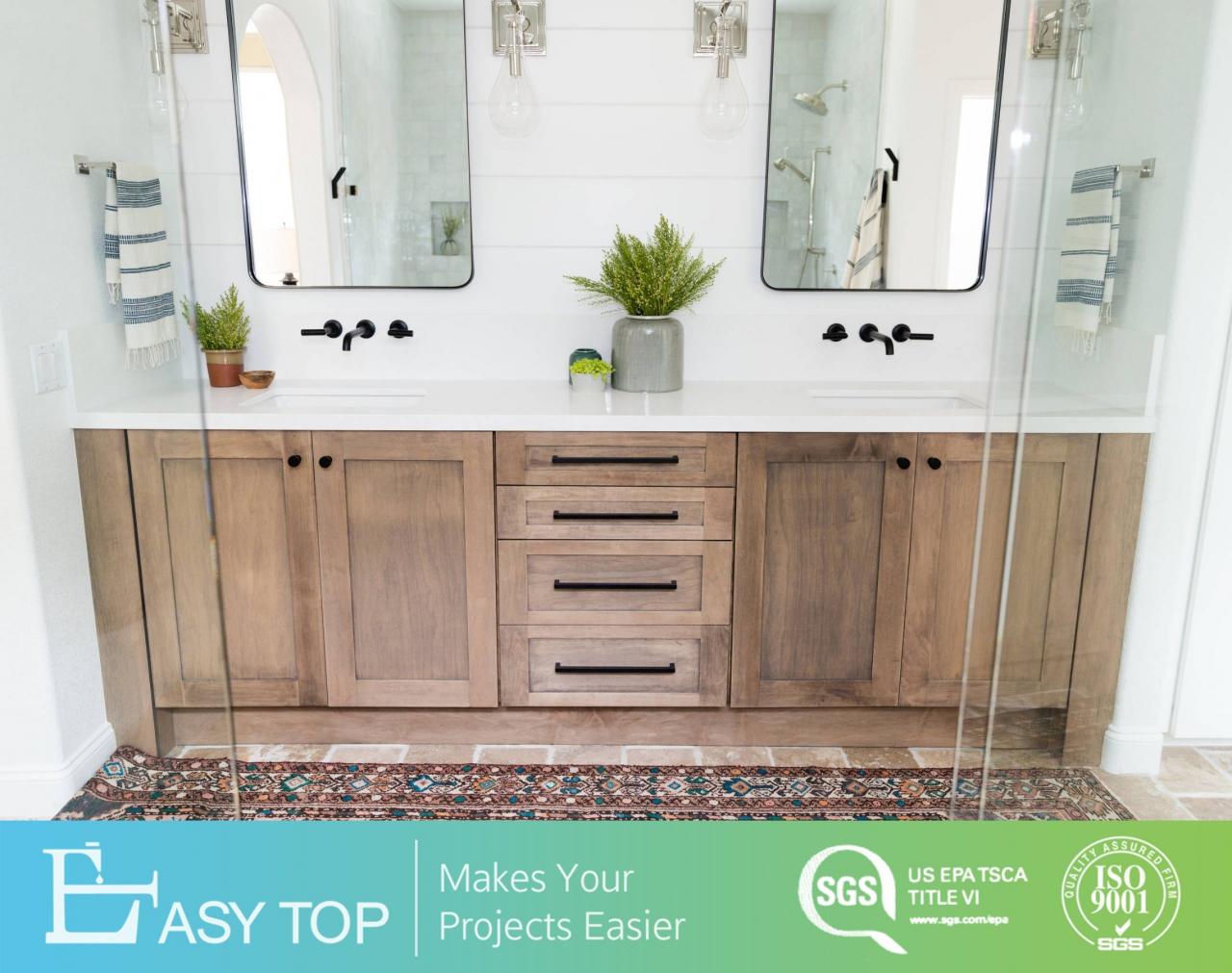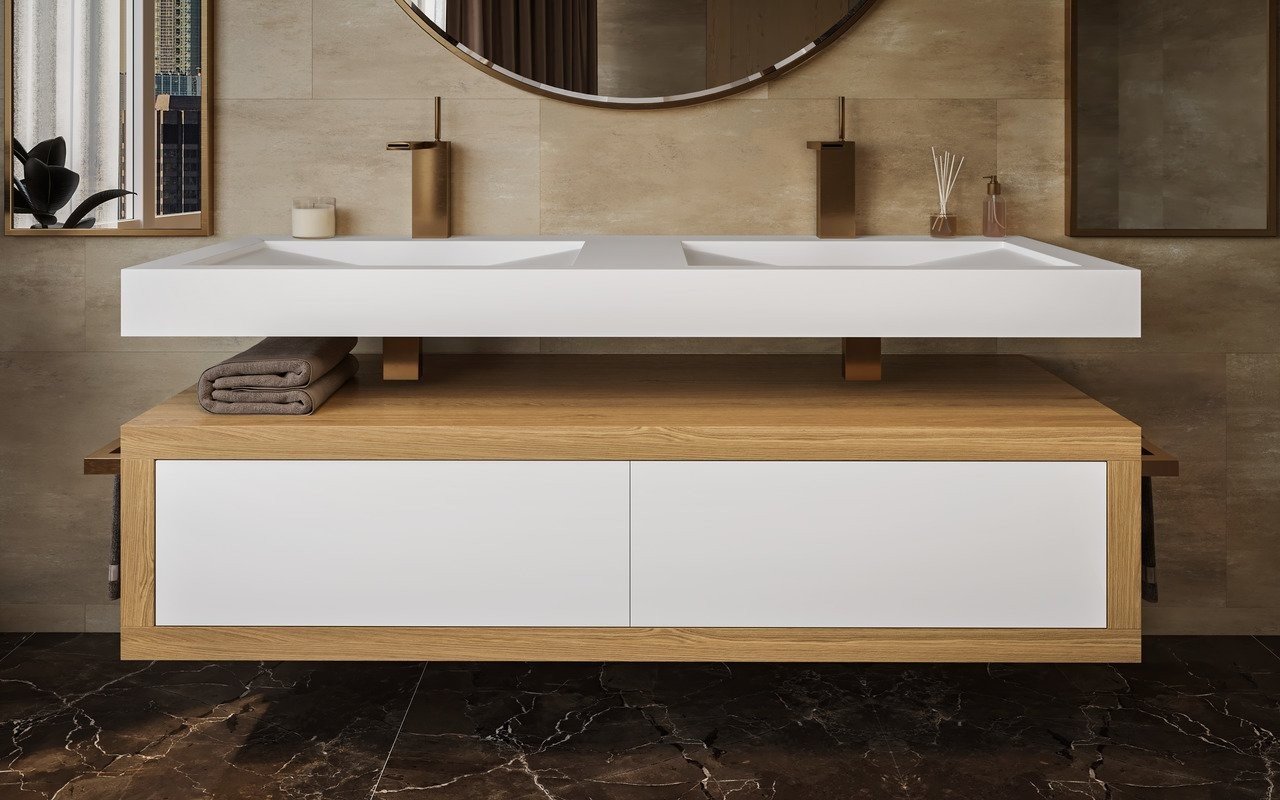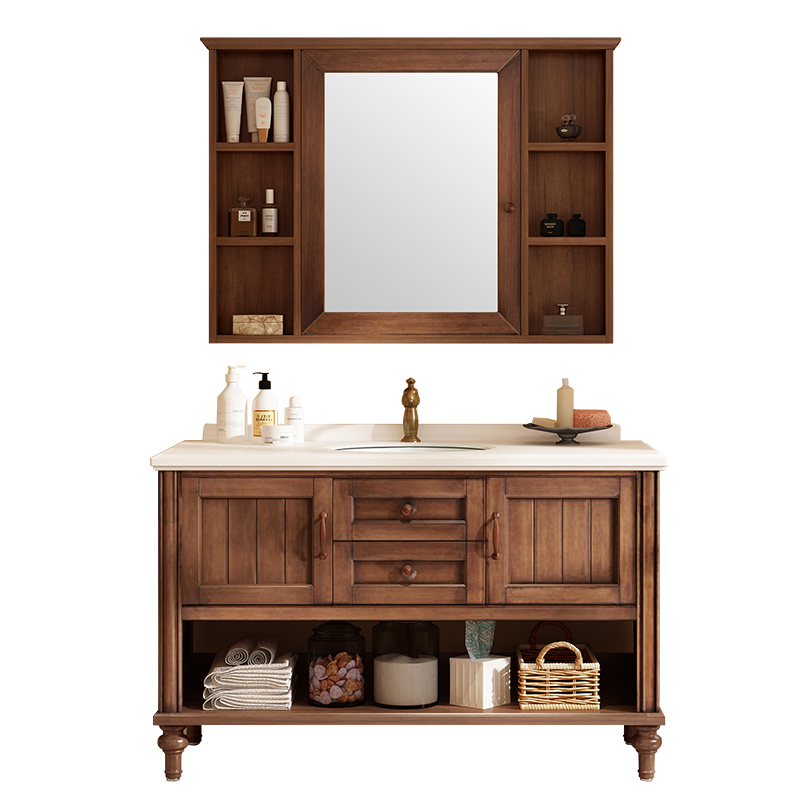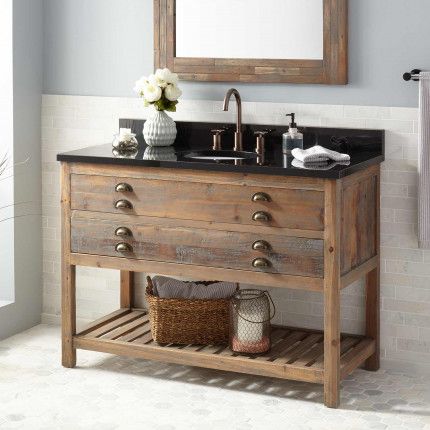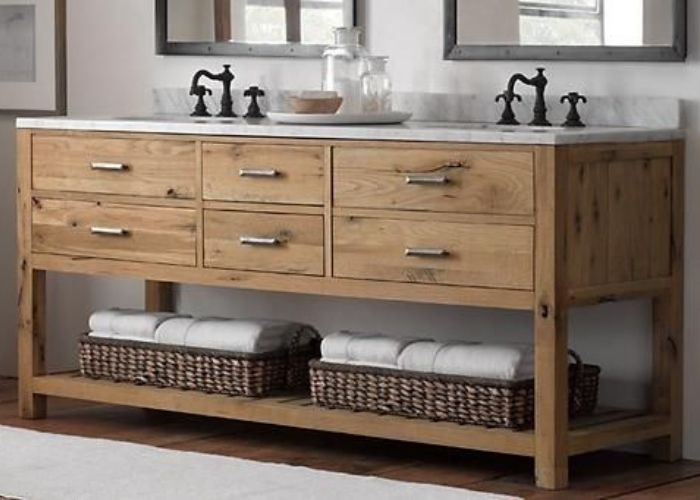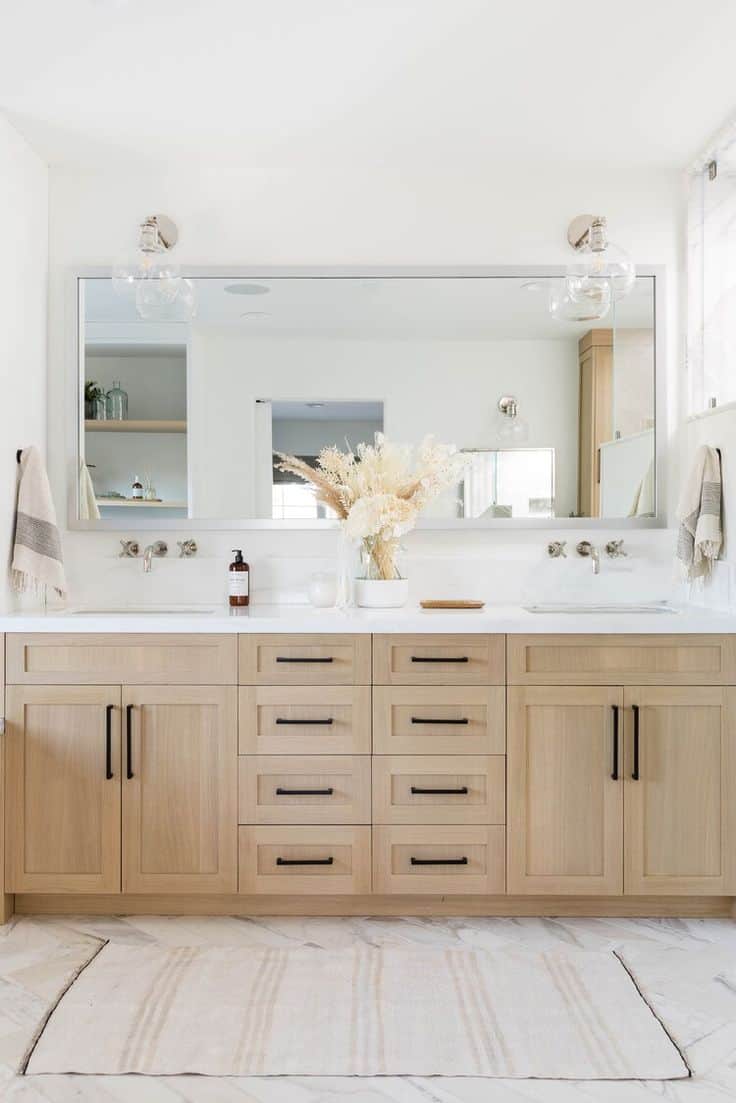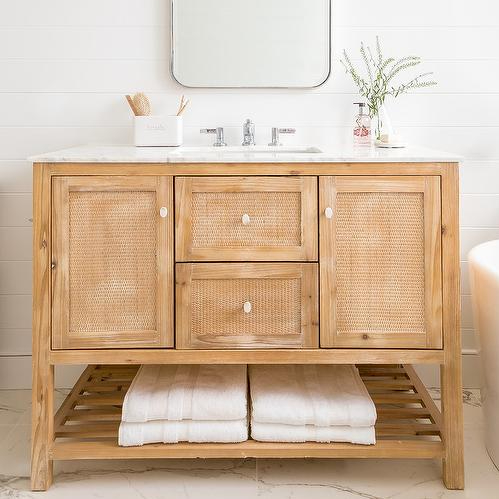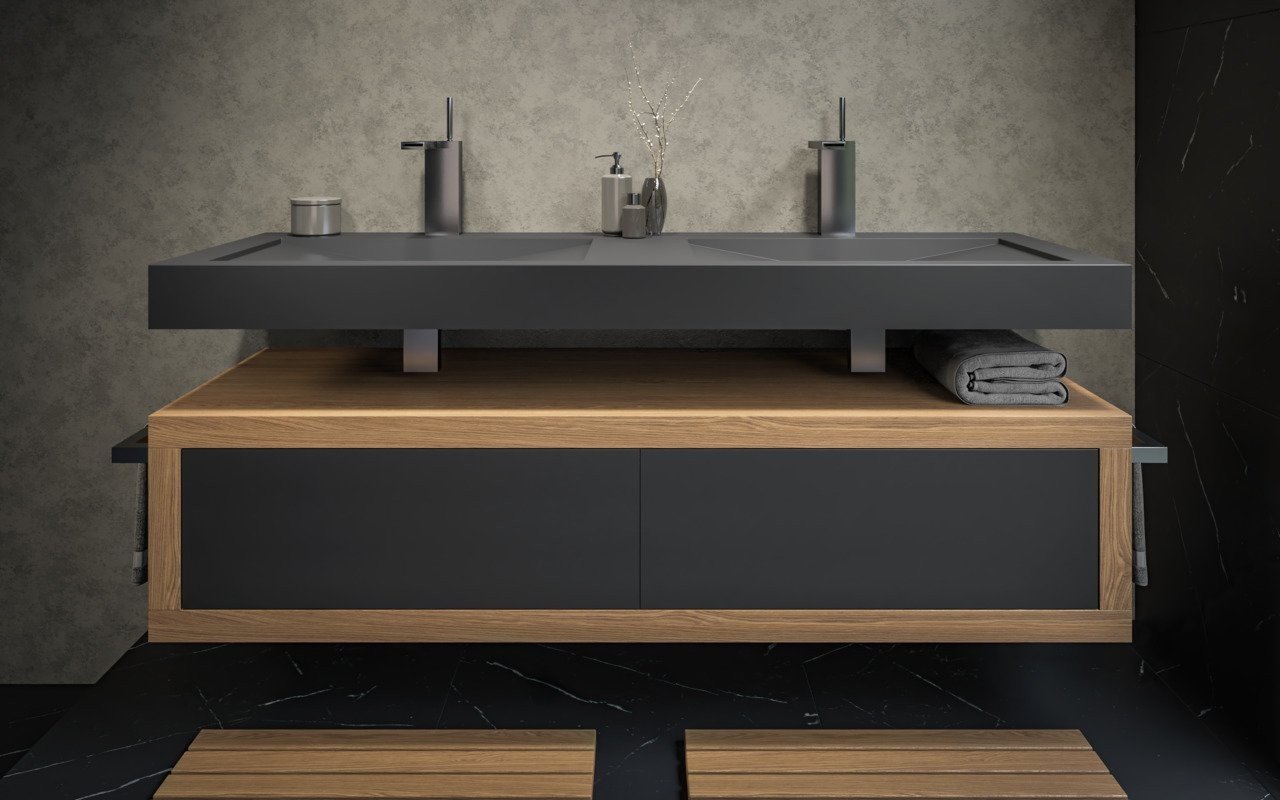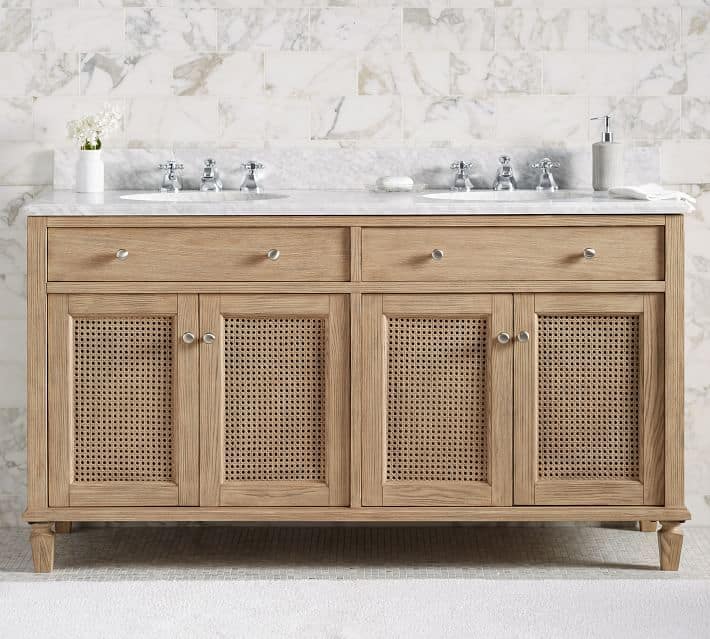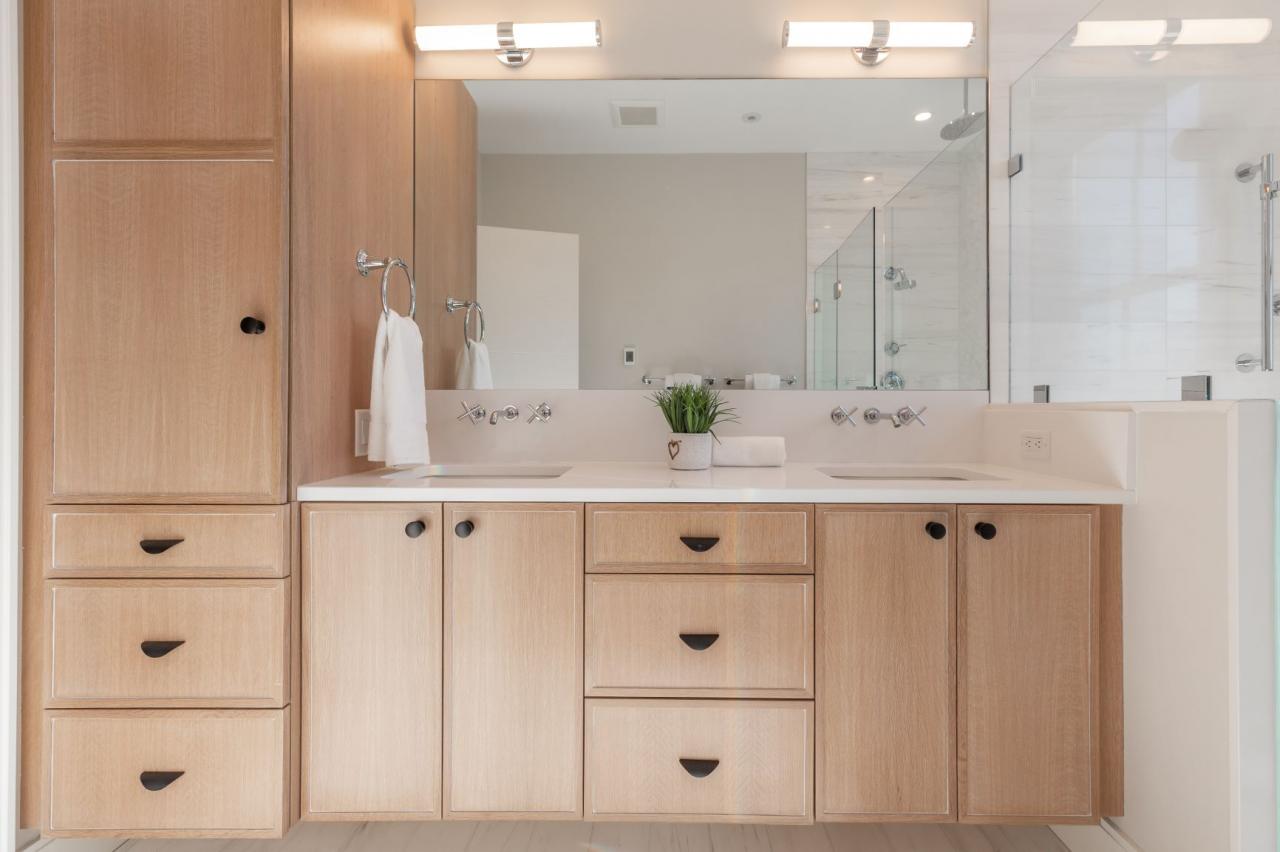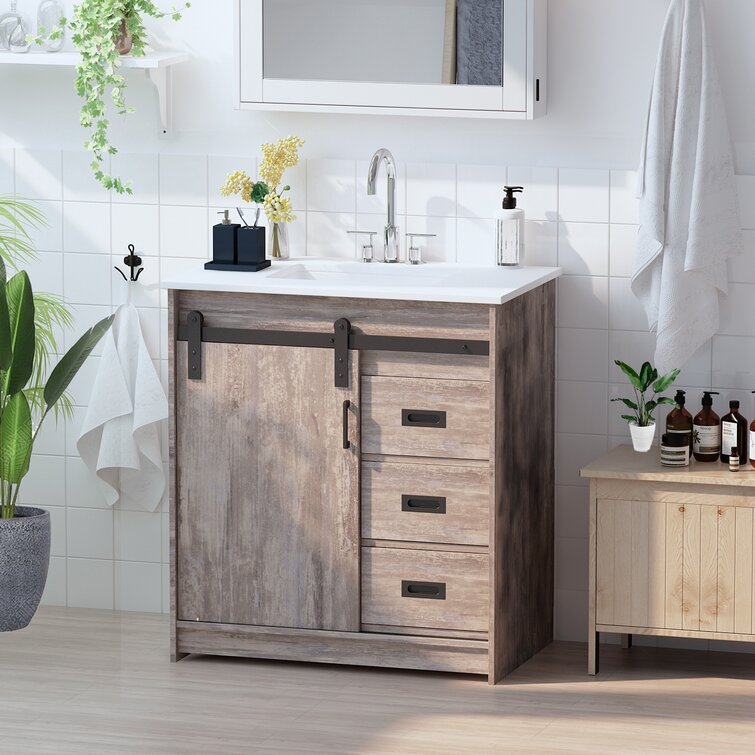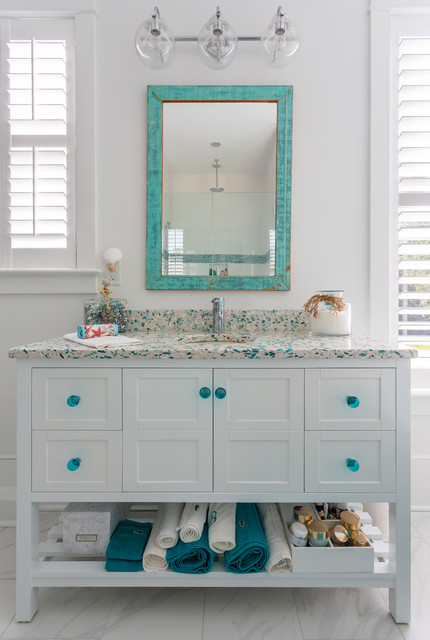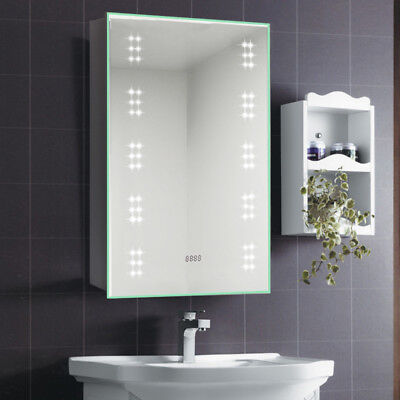Why Wood Is a Popular Choice for Bathroom Cabinets
Wood is a timeless and versatile material that fits perfectly in almost any part of the home, and the bathroom is no exception. Whether you’re going for a sleek, modern look or a more rustic vibe, wood can adapt to your style while bringing a natural warmth to the space. But beyond its visual appeal, wood offers several practical advantages that make it a popular choice for bathroom cabinets.
- Natural Aesthetic Appeal
One of the main reasons people gravitate toward wood for bathroom cabinets is its natural beauty. Wood adds a warm, organic touch to a bathroom, creating a sense of comfort and tranquility. Each type of wood has unique grain patterns and shades, allowing you to personalize your space. From the rich, dark tones of mahogany to the light, airy hues of maple, wood can elevate the look of your bathroom with ease. - Versatility in Design
Wood works well in a variety of bathroom styles, from rustic farmhouses to sleek contemporary designs. Its adaptability means you can pair it with virtually any color palette, material, or finish. If you’re looking to switch things up down the road, wooden cabinets can be refinished, repainted, or stained to match your evolving tastes. - Durability and Strength
High-quality wood is incredibly durable and can withstand daily wear and tear. When properly treated and maintained, wooden bathroom cabinets can last for decades, making it a long-term investment for your home. This durability means you won’t have to worry about replacing cabinets frequently, saving you both time and money. - Customizable and Unique
No two pieces of wood are alike, which makes wooden cabinets feel special and unique. Whether you opt for custom cabinetry or a store-bought option, wood gives you the flexibility to choose the exact look, finish, and style that aligns with your vision. Plus, if you’re inclined, custom-made wooden cabinets can be crafted to fit specific dimensions or features in your bathroom. - Eco-Friendly Material
For those who are environmentally conscious, wood is a sustainable material when sourced responsibly. Choosing wood from certified forests ensures that the material you’re using is renewable and harvested in an eco-friendly way. Many manufacturers also offer reclaimed wood options, giving old wood a new life and reducing the demand for new lumber. - Increases Home Value
Wood cabinetry adds a level of sophistication and quality to a bathroom that other materials may not provide. Potential buyers often view wooden cabinets as a mark of luxury and longevity, which can boost the overall value of your home. Even small bathroom upgrades with wood can enhance the appeal of your home in the eyes of future buyers.
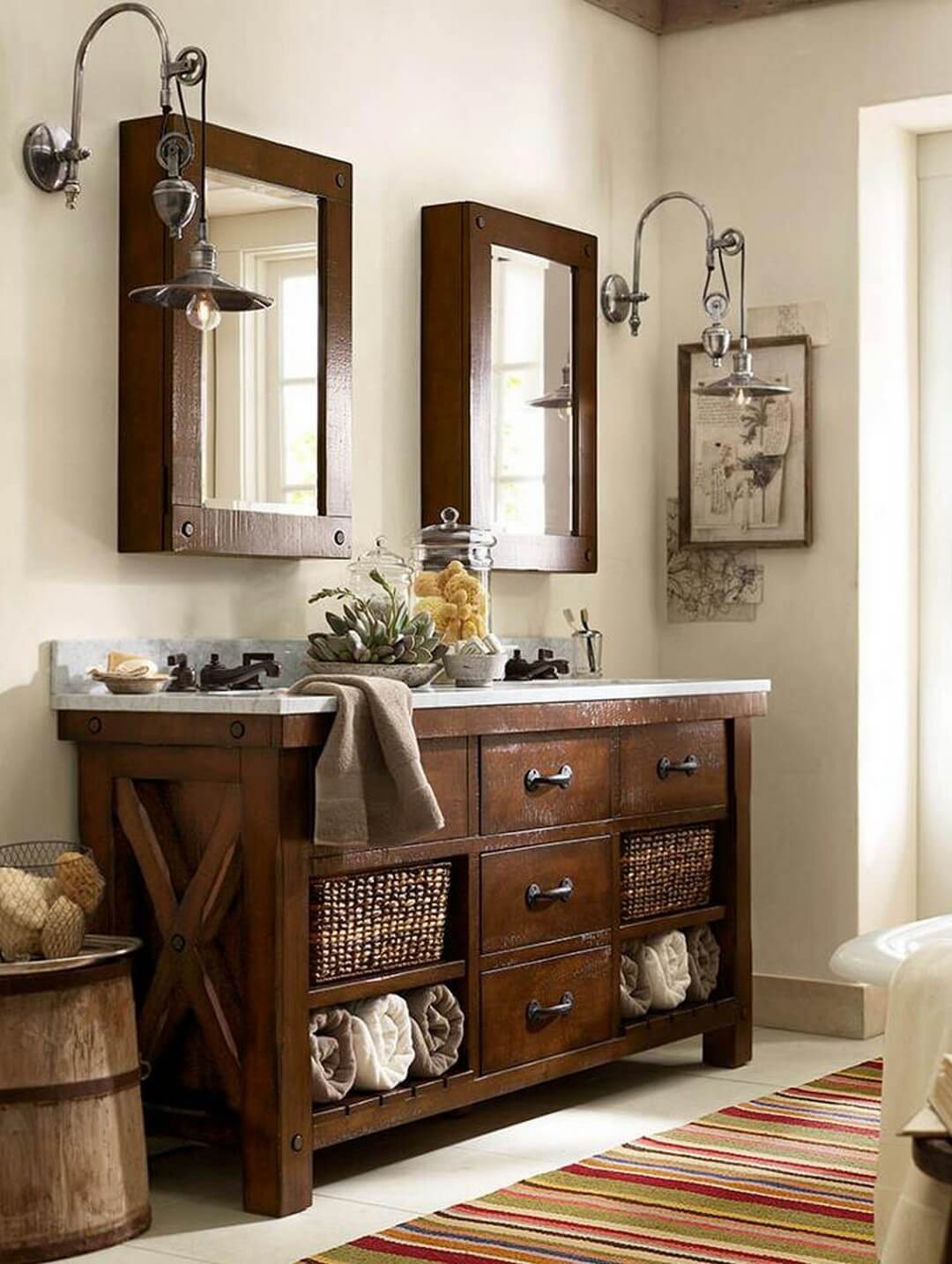
Best Types of Wood for Bathroom Cabinets: An Overview
Choosing the right type of wood for bathroom cabinets is crucial for both aesthetic and functional reasons. Some woods are better suited for moist environments, while others may be more about achieving a certain look. Let’s dive into the best wood options for bathroom cabinetry.
Oak: The Classic Choice
Oak is one of the most common choices for bathroom cabinets due to its durability and versatility. It has a strong, open grain and comes in both red and white varieties, offering different shades to match your decor. Oak holds up well against moisture when properly sealed, making it a reliable choice for bathrooms.
Maple: Light and Durable
Maple is known for its smooth grain and light color, which makes it perfect for modern or minimalist bathroom designs. It’s a hard, dense wood, resistant to warping and cracking, which is ideal for the humid environment of a bathroom. When sealed, maple can withstand moisture quite well, ensuring your cabinets stay in top shape.
Cherry: Rich and Elegant
If you’re looking for a wood that adds a touch of luxury to your bathroom, cherry is a fantastic option. Its rich, reddish-brown tones deepen over time, adding warmth and sophistication to the space. While cherry is more expensive than some other wood types, its beauty and durability make it worth the investment.
Walnut: Deep and Dark
For those who prefer a darker, more dramatic look, walnut is a great choice. It’s a dense wood with a tight grain, offering a sleek, polished appearance. Walnut is relatively resistant to moisture and, with the right finish, can last for many years in a bathroom setting.
Bamboo: Eco-Friendly and Stylish
Bamboo has become increasingly popular for bathroom cabinets due to its sustainability and strength. Technically a grass, bamboo is highly renewable and incredibly durable. Its light, clean appearance fits well in modern, eco-friendly designs. Bamboo also resists moisture, which is crucial for bathrooms.
Teak: The King of Water-Resistant Wood
Teak is one of the best woods for bathrooms, especially in high-humidity environments. It’s naturally water-resistant due to its high oil content, which makes it perfect for bathroom use. Teak is often seen in high-end bathrooms and can withstand moisture, humidity, and even mold with proper care.
Solid Wood vs. Engineered Wood: Which Is Better for Bathroom Cabinets?
When choosing bathroom cabinets, one of the first decisions you’ll face is whether to go with solid wood or engineered wood. Both have their benefits and drawbacks, depending on your priorities—whether it’s durability, cost, or moisture resistance. Let’s break down the pros and cons of each option.
Solid Wood: Timeless and Sturdy
Solid wood is exactly what it sounds like—cabinets made entirely from real wood. This gives it a natural beauty that’s hard to replicate with other materials. Solid wood is incredibly durable and can be sanded down and refinished multiple times, extending its lifespan. However, it can be more expensive and more prone to warping in humid environments like bathrooms.
Engineered Wood: Cost-Effective and Stable
Engineered wood, on the other hand, is made from layers of wood or wood byproducts bound together with adhesives. While it doesn’t offer the same authenticity as solid wood, engineered wood is more stable in moist environments. It’s less likely to warp or crack due to changes in temperature or humidity, making it a good option for bathrooms.
Price Considerations
One of the biggest advantages of engineered wood is the cost. It’s typically less expensive than solid wood, making it a more budget-friendly option. If you’re working with a limited budget but still want the appearance of wood, engineered wood could be the way to go. Solid wood, while pricier, may be worth the investment for its longevity and timeless appeal.
Moisture Resistance
Bathrooms are naturally moist environments, and solid wood can sometimes struggle with the humidity. It can warp, expand, or contract with temperature changes if not properly sealed. Engineered wood, because of its layered construction, is generally more resistant to these fluctuations, making it a safer bet for long-term use in bathrooms.
Aesthetic Differences
While engineered wood can mimic the appearance of solid wood, it’s hard to replicate the true grain and texture of natural wood. Solid wood offers a more authentic, high-end look, especially if you’re going for a rustic or traditional bathroom style. Engineered wood, however, can still provide a clean, polished appearance that works well in modern or contemporary bathrooms.
Durability and Longevity
Solid wood is known for its longevity, especially if properly maintained and treated for moisture. It can last for decades and, as mentioned earlier, be refinished to restore its original beauty. Engineered wood, while not as long-lasting as solid wood, offers good durability for its price. However, it can be harder to repair or refinish once damaged.
Water Resistant Wood for Humid Bathroom Conditions
Bathrooms are one of the most moisture-prone areas of the home, making water-resistant wood a critical consideration for cabinetry. The last thing you want is for your cabinets to warp, swell, or mold due to humidity. Luckily, certain types of wood, combined with the right treatments, can handle the damp environment of a bathroom.
Teak: Naturally Water-Resistant
Teak is the go-to option for bathrooms with high humidity. Its natural oils make it highly resistant to moisture, mold, and mildew. This is why teak is often used in outdoor furniture and boat building. If you’re looking for a wood that can handle constant exposure to water, teak is the best choice.
Cedar: Naturally Moisture-Repellent
Cedar is another excellent option for bathroom cabinets, known for its aromatic properties and natural resistance to moisture. The oils in cedar help repel water, making it a good choice for humid spaces like bathrooms. Plus, it adds a refreshing, natural scent to the room.
Bamboo: An Eco-Friendly Option
Though not technically wood, bamboo is highly moisture-resistant and increasingly popular in bathroom cabinetry. Bamboo is naturally resistant to swelling and warping, making it ideal for humid environments. Its modern aesthetic and eco-friendly appeal make it a standout choice for those looking to incorporate sustainable materials.
Ipe: The Outdoor Wood That Works Indoors
Ipe is an extremely dense, hardwood often used for outdoor decking. It’s naturally resistant to moisture, insects, and rot, making it a solid option for bathrooms. While it’s more expensive, its durability ensures that you won’t need to replace your cabinets anytime soon.
Mahogany: Dense and Durable
Mahogany is another durable wood that can withstand humid conditions. Its tight grain and dense structure make it less susceptible to moisture absorption. Mahogany cabinets are not only functional but also bring a luxurious feel to any bathroom.
Proper Sealing and Maintenance
While some woods are naturally moisture-resistant, adding a high-quality sealant can enhance their water-repelling properties. Regular maintenance, such as resealing or oiling the wood, will ensure that your bathroom cabinets remain in pristine condition despite the humid environment.
Wood Finishes and Sealants to Protect Bathroom Cabinets
Choosing the right wood finish and sealant is just as important as selecting the type of wood for your bathroom cabinets. The finish you apply will protect the wood from moisture, stains, and daily wear, ensuring the longevity of your investment. Here’s a guide to some of the best finishes and sealants for bathroom cabinets.
Polyurethane: A Durable, Waterproof Finish
Polyurethane is one of the most commonly used finishes for bathroom cabinets due to its durability and water resistance. It forms a tough, protective layer on the wood, shielding it from moisture and humidity. Available in both oil-based and water-based options, polyurethane can give your cabinets a glossy or matte finish depending on your preference.
Varnish: Traditional Protection
Varnish is another durable option that offers excellent protection against water and moisture. It penetrates the wood and hardens to create a waterproof barrier. Varnish is typically clear, allowing the natural beauty of the wood grain to shine through, but it can also be tinted for a different look.
Oil Finishes: Enhancing Natural Beauty
For those who want to enhance the natural look of the wood, oil finishes like tung oil or linseed oil are great choices. These oils penetrate deep into the wood and harden over time, offering moderate protection from moisture. While they’re not as waterproof as polyurethane or varnish, they bring out the richness and depth of the wood grain.
Water-Based Sealants: Eco-Friendly and Easy to Apply
Water-based sealants are gaining popularity due to their low VOC content and easy application. They provide a clear, durable finish that protects the wood without yellowing over time, making them ideal for light-colored woods like maple or bamboo.
Lacquer: Fast-Drying and Glossy
Lacquer is a fast-drying finish that provides a hard, glossy surface. While it’s not as durable as polyurethane or varnish, it’s often used for its high-gloss finish and smooth texture. Lacquer can be a good option for bathrooms if you want a sleek, polished look.
Regular Maintenance to Prolong Life
No matter what finish you choose, regular maintenance is key to keeping your bathroom cabinets in great condition. Over time, finishes can wear down, so it’s important to reapply sealants or oils as needed. Regular cleaning and wiping down cabinets will also help maintain the protective layer, preventing water damage in the long run.
Sustainable Wood Choices for Eco-Friendly Bathroom Cabinets
As more homeowners are looking for eco-friendly options, sustainable wood choices are becoming a key consideration for bathroom cabinetry. Choosing wood that is responsibly sourced or reclaimed can significantly reduce the environmental impact of your bathroom remodel.
Bamboo: A Fast-Growing, Renewable Resource
Bamboo is one of the most sustainable materials available for bathroom cabinets. It’s a highly renewable resource, growing much faster than traditional hardwoods. Bamboo also has excellent moisture resistance, making it a practical and eco-friendly choice for bathrooms.
Reclaimed Wood: Giving New Life to Old Materials
Reclaimed wood is another fantastic eco-friendly option. By using wood that has been salvaged from old buildings, barns, or furniture, you’re reducing the demand for new lumber and giving old materials a new purpose. Reclaimed wood brings unique character to bathroom cabinets, with its weathered look and rich history.
Cork: Lightweight and Renewable
Cork, while not traditionally used for cabinets, is a lightweight and renewable material that’s gaining popularity in sustainable design. Harvested from the bark of cork oak trees, it’s both renewable and biodegradable. Cork is also moisture-resistant, making it a suitable option for bathroom environments.
FSC-Certified Wood: Ensuring Responsible Sourcing
When purchasing wood for bathroom cabinets, look for the Forest Stewardship Council (FSC) certification. This certification ensures that the wood has been harvested from responsibly managed forests that meet high environmental and social standards. By choosing FSC-certified wood, you’re supporting sustainable forestry practices.
Teak: Sustainable When Sourced Responsibly
While teak is known for its durability and water resistance, it’s important to source it responsibly. Teak trees take a long time to mature, and unsustainable harvesting can lead to deforestation. Opting for FSC-certified or reclaimed teak ensures that your cabinets are eco-friendly and ethical.
Eco-Friendly Finishes and Sealants
In addition to choosing sustainable wood, consider using eco-friendly finishes and sealants. Look for products with low volatile organic compounds (VOCs), which are better for both the environment and indoor air quality. Water-based finishes are a great option for reducing your environmental impact.
Maintaining and Caring for Wooden Bathroom Cabinets
Once you’ve installed your beautiful wooden bathroom cabinets, proper care and maintenance are essential for keeping them in top condition. With the right approach, your cabinets can last for years, even in the humid environment of a bathroom.
Regular Cleaning to Prevent Moisture Build-Up
One of the most important steps in maintaining wooden bathroom cabinets is regular cleaning. Wipe down the cabinets with a soft cloth to remove any water splashes or moisture build-up. Avoid using harsh chemicals or abrasive cleaners that can damage the wood finish. A simple solution of mild soap and water works best.
Protecting the Wood from Water Damage
Wood and water don’t mix well, so it’s essential to take precautions to protect your cabinets from moisture. Use rugs or mats to prevent water from pooling near the base of your cabinets. If you notice any water splashes on the wood, wipe them up immediately to avoid staining or warping.
Reapplying Sealants and Finishes
Over time, the sealant or finish on your cabinets may wear down, making the wood more vulnerable to water damage. Periodically check the condition of the finish, and reapply as needed. This is especially important in high-humidity areas like bathrooms, where moisture exposure is constant.
Addressing Scratches and Dents
Wooden cabinets can develop scratches or dents over time, especially in high-traffic areas. If you notice any damage, address it promptly by sanding down the affected area and applying a matching finish. This will prevent the damage from worsening and keep your cabinets looking fresh.
Ventilation Is Key
Proper ventilation in the bathroom is crucial for preserving the condition of your wooden cabinets. Ensure your bathroom is well-ventilated to prevent excess humidity from causing the wood to warp or rot. Installing a bathroom fan can help reduce moisture levels and prolong the life of your cabinets.
Routine Inspections for Mold and Mildew
Since bathrooms are humid environments, it’s essential to check your cabinets regularly for signs of mold or mildew. If you spot any, clean the area immediately with a mild bleach solution or a mixture of vinegar and water. Preventing mold growth will protect both the wood and the health of your home.
Light Wood Bath Cabinets With Cane Cabinet Doors – Buy Bathroom
Aquatica Millennium-Blck 150 Stone And Wood Bathroom Vanity
Natural Wood Bathroom Vanities for Inspiration
Warm Wood Vanities – Metropolitan Cabinets
29.9″ W x 18.8″ D x 33.3″ H Single Sinks Accommodated Bathroom Vanity
Related articles:
- Bathroom Cabinets San Jose
- Cheap Bathroom Cabinet Ideas
- Master Bathroom Cabinets Photos
- Bathroom Cabinets Dubai
- Modern Bathroom Cabinet Handles
- Bathroom Cabinets With Doors
- 19 Inch Deep Bathroom Cabinets
- Sherwin Williams Bathroom Cabinet Paint Colors
- Corner Bathroom Cabinets Without Mirror
- Narrow Corner Bathroom Cabinet
